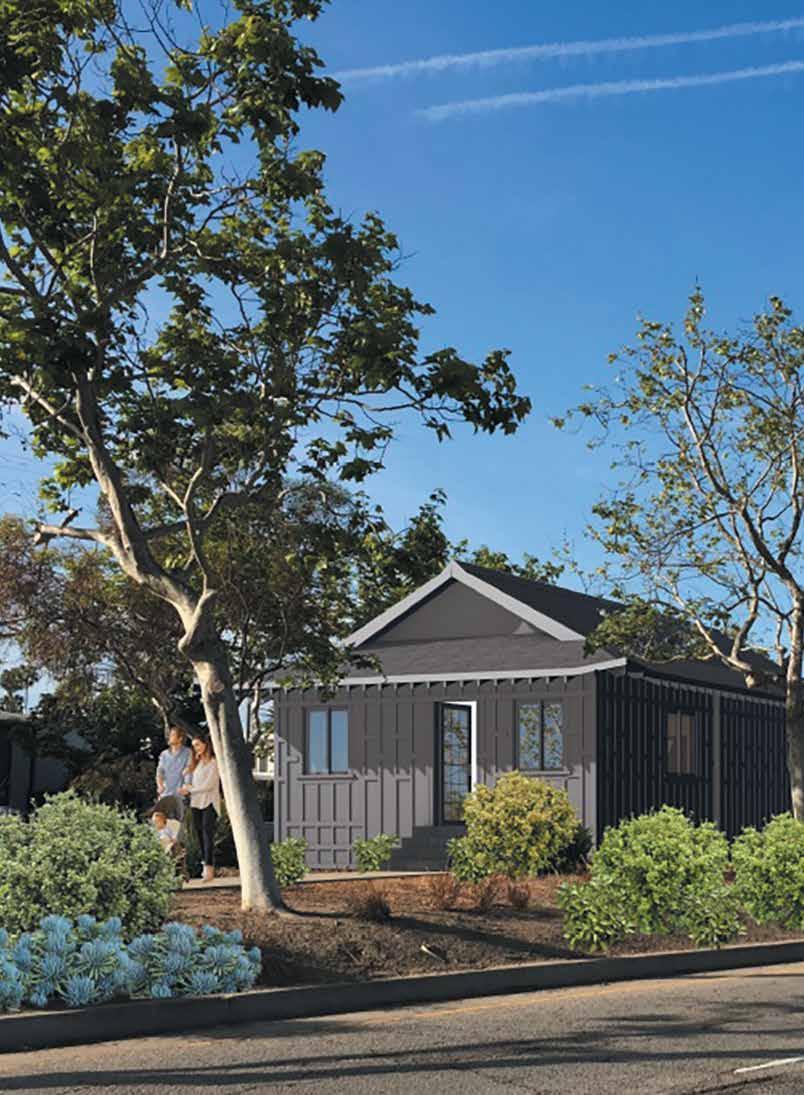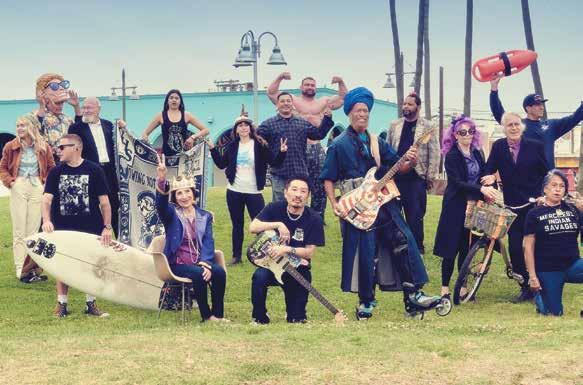
7 minute read
COVER STORY
Capturing Venice’s Heritage
Foundation raising money to open museum in Red Car trolley
By Bridgette M. Redman Takara Tomeoni Adair knew what she’d do if she ever won the lottery. She would use the money to build a museum in her hometown of Venice. Then a Google search informed her that she wouldn’t have to wait for lightning to strike because others shared her dream and were in the process of making it happen. “I have to know these people,” said Adair, who is now on the Venice Heritage Museum Foundation board. “I have to be involved. I can’t believe these people are here and they’re doing this work. It was brilliant. It was beautiful.” In mid-April, the Foundation launched an Indiegogo campaign to raise money for what many people are surprised doesn’t already exist. The museum, which will be built in Centennial Park to have a campus-like atmosphere that will be a gathering place for the community, will house stories, artifacts, archives and art collections that celebrate Venice’s 100-plus years of history. For a small town, Venice has a rich history that has changed the world. It is the birthplace of The Doors, and the architecture of Frank Gehry. It is home to Muscle Beach, to the Light and Space art movement, to Dogtown and Z-Boys skateboarders. Ray Bradbury has connections to Venice and is an honorary board member of the Venice Heritage Museum. Kristina von Hoffmann is a second-generation board member who is now the secretary of the board, and her father was the founding president. “He likes to say I’ve succeeded him and improved on his contributions; I look at it as a generational passing of the torch,” said von Hoffmann. Von Hoffmann explained that the board has four different generations serving on it from the Silent Generation and boomers to Gen Xers and millennials. She said they will be centering stories of the diverse populations of Venice starting with the Tongva First Peoples. They have enlisted the help of a Tongva elder to collect artifacts and create an exhibit devoted to Venice’s First Peoples. They also plan to highlight the historic black neighborhoods of generations that came from the Deep South for a better life on the West Coast. “No other city next to the beach in Los Angeles is as diverse as Venice,” von Hoffmann said, further listing Mexicans, Central Americans, Latin Americans, Japanese Americans and Korean Americans. “We have so many stories of resilience and so many cultural movements…That’s why we need a museum — to capture all these stories of our cultural identities and people’s creative identities.”
Plans start with renovating a trolley
Museum has donated one of the original Pacific Electric Red Car trolleys that ran from downtown LA to Venice Beach — known as the Venice Short Line. The project architect, David Hertz and the Studio of Environmental Architecture, let them know about a local historic bungalow that was going to be demolished. He donated the nostalgic building to the Venice Heritage Museum. It will be transformed into a replica of the Tokio Ticket Station. “These two historic structures are living history themselves,” von Hoffmann said. “And will provide us space for our exhibitions and to some extent, our archives.” They’ve received conditional approval from the City of Los Angeles Department of Recreation and Parks to build the Venice Heritage Museum in Centennial Park at Abbot Kinney and Venice Boulevard. They have volunteers, plans and resources lined up.
The Venice Heritage Museum Foundation is raising funds to build the city’s first-ever museum to preserve, showcase and celebrate Venice’s historical legacy.
Fundraising takes on an urgency to win approval
to complete and operate Phase I of their business plan. Phase I includes the restoration of the trolley car, which will be the primary structure of the museum and the cost of transporting it to the museum campus site. The original plan was to launch a fundraising campaign on the 115th birthday of Venice’s founder, Abbot Kinney. But 2020 happened and those plans had to be delayed. Phase 1 funding will require $115,000 and covers the following expenses: • Moving the trolley from the Orange Empire Railway
Museum in Perris, California to a nearby renovation site • Paying for rent, maintenance and insurance at the temporary site • Professionally detoxing and restoring the trolley • Prepping the park site and moving the trolley to Centennial Park after the exterior has been renovated • Paying a professional grant writer to pursue money funds for the next phases and hosting fundraising events • Partially funding Phase II to demonstrate to city authorities that they can maintain the operations onsite After setting up the museum in the trolley car, the board will add the replica of the Tokio Station ticketing booth. The original stood in front of Venice City Hall. This building will provide archival space and be a meeting center for the community. In order to receive the donated building, the Venice Heritage Museum Foundation must collect $115,000 to complete Phase I and prepare for Phase II. They hope to break ground in early 2022 and open to the public in Summer 2023. The Red Car trolley and the Tokio Station are only the beginning. The Venice Heritage Museum campus will also have several outdoor spaces designed to bring the community together. In the southwest corner will be a community corner stage that will act as a town square. There will be four gardens around the museum and an information booth where visitors can learn about Venice businesses and receive recommendations for local places to visit. Each month, it will feature a different local small business or maker. The Community Corner is designed for events, live music, film nights and classes. It will also serve as an affordable rental space for guest events with the rental money going to support museum operations.
Calling upon the community for grassroots support
The first major fundraising campaign is Indiegogo because they wanted to lead with something that was accessible to the community. “Truly, the first big public push at this period of time to support the museum is a community-led effort,” von Hoffmann said. “That’s the spirit we want at the heart. We hope people can help out, whether it’s a donation or helping to spread the word by telling friends and families about this campaign. We want to see that energy reflected back to us by a groundswell of support.” Depending on the level of gift, there are several perks that donors can walk away with. The basic starts with “The Boardwalk Special”, which has a pack of incense, a postcard, a Venice Heritage Museum sticker and matchbook. Others include T-shirts, vintage prints of Venice, signed original artist prints, and a Pep Williams signed print. Larger donors can see their names permanently installed at the museum, either as part of a mosaic wall, a commemorative brick on a walking path, a founding donor plaque, a peace stepping stone on the path of peace or a Red Car window plaque. The top donors earn the right to name the information booth, the community corner, Tokio Station and the Red Car. Adair wants the community to know that it will take everyone to bring the vision to life. “We all need to care,” Adair said. “We’re going to need the community to help with the content. We’re going to have to go to the community to build this museum in every way. I want everybody to feel like a piece of them is represented. If there are people and groups we don’t know about — then tell us your story.” Adair said it is still unreal to her that Venice does not already have a museum given the impact that Venice has had on the world. She lists such things as tattooing becoming mainstream, Charlie Chaplin, The Doors and bodybuilders. “All of those things are worthy of any small town museum,” Adair said. “We have so much to offer. We have contributed so much to the world as a community. We have a voice in terms of diversity and how people can co-exist together with multibelief systems. We have religious and socioeconomic diversity. We are this very unique place.” The Indiegogo fundraising campaign can be found at indiegogo.com/projects/ we-re-building-a-museum-forvenice#/ The museum campus, which will be located in Centennial Park, will serve as a common ground for all of Venice’s residents and visitors.








